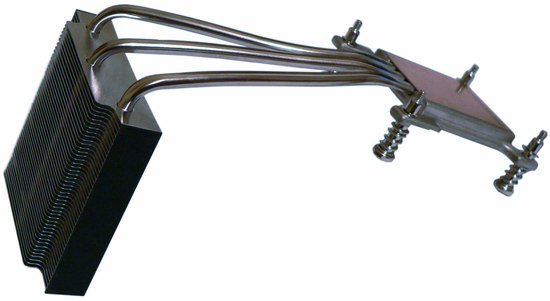Cooling system and temperature conditions
The cooling system is similar to what is used in G5 enclosures, although the CPU cooler looks a tad simplified. In particular, only three heat pipes are used instead of four.
BIOS allows to choose a fully automatic SmartFan mode, which controls rotational speed of the main fan depending on CPU temperature. Or you can limit fan speed to Medium, Low, and Ultra Low. Fan speed will be limited until CPU temperature reaches 75°C. Then the fan will speed up to maximum. SmartFan is preferable from the practical point of view, of course. But if variable noise irritates you, you can choose a mode with a fixed fan speed, when it does not accelerate to maximum even under maximum load (in your case).
Rotational speed of the PSU fan is controlled automatically depending on readings of the built-in thermal sensor. Unfortunately, BIOS does not provide monitoring tools.
CPU cooler bears apparent signs of economy, only heat pipes and the base are made of copper, the heatsink is made of thin aluminum plates, so it's not heavy.
The chipset is cooled by a 90-mm fan, which also acts as the main element of the cooling system for all other components inside the enclosure. Note well-thought-out installation of the cooler: it's practically impossible to do anything wrong, as you screw the cooler on the CPU. What concerns a fan on the rear panel, it's attached with special screws, which do not require a screwdriver.
SilentX 300-W power supply unit is marked not to raise the power of +5 and +3.3 V lines above 110 W. It's powerful enough for a robust configuration.
We tested heat dissipation with SpeedFan, automatic SmartFan mode was enabled in BIOS. The system was bundled with AMD Athlon 64 X2 4000+ (Windsor core, 90 nm, TDP=89 W), ATI Radeon HD4850 512 MB graphics card (for discrete graphics tests), ESI Juli@ sound card, Samsung 7200 rpm hard drive, and DVD drive. Maximum system load was generated by FarCry running in high resolution and a built-in WinRAR benchmark (with low priority for the unrar process in Windows Task Manager). HD Video playback was tested with an MPEG2 HD video clip (1080p, 25 MB/s bitrate). CPU usage in this case did not exceed 60%.
The cooling system demonstrates good thermal efficiency in idle mode and during HD Video playback. The main fan rotated at the speed of 900-926 rpm, so the computer was barely noisy. Under maximum load the fan accelerated to 2600-2800 rpm and the noise level became quite audible, but not very high. There are no formal reasons for such acceleration, so you may try Low or Ultra Low modes in BIOS, because these components can operate at higher temperatures. On the other hand, we have an impression that the simplified design of the CPU cooler (compared to G5 models) has to do with something more than just exterior. The cooler channels the heat less efficiently, and the fan has to raise its speed to reach the same temperature level.
An additional on-board sensor may be installed near the CPU voltage regulator. In this case we can say that the regulator has a wide safety margin, because its components (field-effect transistors and coils) are designed for much higher temperatures.
A graphics card practically does not contribute to the general noise level: the main fan did not speed up above 1300 rpm in idle mode and during HD Video playback. Subjectively, PSU fans also operated in the same mode. Under maximum load, the main fan speeds up to the same level (2800 rpm). However, the overall noise level grows, of course, because the GPU fan in this mode accelerates from the noiseless to barely audible level, which still contributes to the orchestra.
Operating temperatures of the graphics card are no different from what it demonstrates in a standard PC case. We should also note high HDD cooling efficiency. The chipset with its passive cooling is far from overheating as well. In conclusion I'd like to say that Shuttle has proved again that it can design PC enclosures, where the cooling problem can be solved with the lowest noise level (in comparison with competing products). However, the same components can be accommodated in a full-sized PC enclosure to produce even less noise. On the other hand, AMD already offers Athlon X2 processors with TDP=65 or even 45 W, while we've tested a borderline case. Even if you want to assemble a gaming computer in such enclosure, this processor is still not the best choice. Athlon X2 6000+ with the same TDP of 89 W will reveal the full potential of Radeon HD4850, and it will be much faster.
Write a comment below. No registration needed!



